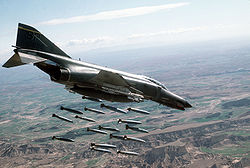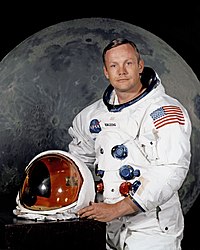Portal:Aviation
| Main page | Categories & Main topics |
|
Tasks and Projects |
The Aviation Portal

Aviation includes the activities surrounding mechanical flight and the aircraft industry. Aircraft includes fixed-wing and rotary-wing types, morphable wings, wing-less lifting bodies, as well as lighter-than-air craft such as hot air balloons and airships.
Aviation began in the 18th century with the development of the hot air balloon, an apparatus capable of atmospheric displacement through buoyancy. Some of the most significant advancements in aviation technology came with the controlled gliding flying of Otto Lilienthal in 1896; then a large step in significance came with the construction of the first powered airplane by the Wright brothers in the early 1900s. Since that time, aviation has been technologically revolutionized by the introduction of the jet which permitted a major form of transport throughout the world. (Full article...)
Selected article

Selected image

Did you know
...that the Heinkel He 46, designed for the Luftwaffe in 1931, was still being used to fight the Soviets in 1943? ...that passengers aboard JetBlue Airways Flight 292 were able to watch their own malfunctioning aircraft circle Los Angeles International Airport on the satellite television screens at each seat until the flight crew disabled the system in preparation for the aircraft's successful emergency landing? ... that Chesley "Sully" Sullenberger, the captain of US Airways Flight 1549, also runs an aviation safety consultant company and has worked as an accident investigator for the USAF, NTSB, and FAA?
General images -
In the news
- May 29: Austrian Airlines cancels Moscow-bound flight after Russia refuses a reroute outside Belarusian airspace
- August 8: Passenger flight crashes upon landing at Calicut airport in India
- June 4: Power firm helicopter strikes cables, crashes near Fairfield, California
- January 29: Former basketball player Kobe Bryant dies in helicopter crash, aged 41
- January 13: Iran admits downing Ukrainian jet, cites 'human error'
- January 10: Fire erupts in parking structure at Sola Airport, Norway
- October 27: US announces restrictions on flying to Cuba
- October 3: World War II era plane crashes in Connecticut, US, killing at least seven
- September 10: Nevada prop plane crash near Las Vegas leaves two dead, three injured
- August 6: French inventor Franky Zapata successfully crosses English Channel on jet-powered hoverboard
Related portals
Associated Wikimedia
The following Wikimedia Foundation sister projects provide more on this subject:
-
Commons
Free media repository -
Wikibooks
Free textbooks and manuals -
Wikidata
Free knowledge base -
Wikinews
Free-content news -
Wikiquote
Collection of quotations -
Wikisource
Free-content library -
Wikiversity
Free learning tools -
Wikivoyage
Free travel guide -
Wiktionary
Dictionary and thesaurus
Selected biography
Before becoming an astronaut, Armstrong was in the United States Navy and saw action in the Korean War. After the war, he served as a test pilot at the National Advisory Committee for Aeronautics (NACA) High-Speed Flight Station, now known as the Dryden Flight Research Center, where he flew over 900 flights in a variety of aircraft. As a research pilot, Armstrong served as project pilot on the F-100 Super Sabre A and C aircraft, F-101 Voodoo, and the Lockheed F-104A Starfighter. He also flew the Bell X-1B, Bell X-5, North American X-15, F-105 Thunderchief, F-106 Delta Dart, B-47 Stratojet, KC-135 Stratotanker and Paresev. He graduated from Purdue University.
Selected Aircraft

The McDonnell Douglas F-4 Phantom II is a two-seat, twin-engined, all-weather, long-range supersonic fighter-bomber originally developed for the U.S. Navy by McDonnell Aircraft. Proving highly adaptable, it became a major part of the air wings of the U.S. Navy, U.S. Marine Corps, and U.S. Air Force. It was used extensively by all three of these services during the Vietnam War, serving as the principal air superiority fighter for both the Navy and Air Force, as well as being important in the ground-attack and reconnaissance roles by the close of U.S. involvement in the war.
First entering service in 1960, the Phantom continued to form a major part of U.S. military air power throughout the 1970s and 1980s, being gradually replaced by more modern aircraft such as the F-15 Eagle and F-16 Fighting Falcon in the U.S. Air Force; the F-14 Tomcat and F/A-18 Hornet in the U.S. Navy; and the F/A-18 in the U.S. Marine Corps. It remained in use by the U.S. in the reconnaissance and Wild Weasel roles in the 1991 Gulf War, finally leaving service in 1996. The Phantom was also operated by the armed forces of 11 other nations. Israeli Phantoms saw extensive combat in several Arab–Israeli conflicts, while Iran used its large fleet of Phantoms in the Iran–Iraq War. Phantoms remain in front line service with seven countries, and in use as an unmanned target in the U.S. Air Force.
Phantom production ran from 1958 to 1981, with a total of 5,195 built. This extensive run makes it the second most-produced Western jet fighter, behind the F-86 Sabre at just under 10,000 examples.
- Span: 38 ft 4.5 in (11.7 m)
- Length: 63 ft 0 in (19.2 m)
- Height: 16 ft 6 in (5.0 m)
- Engines: 2× General Electric J79-GE-17A axial compressor turbojets, 17,845 lbf (79.6 kN) each
- Cruising Speed: 506 kn (585 mph, 940 km/h)
- First Flight: 27 May 1958
- Number built: 5,195
Today in Aviation
- 2011 – NATO conducts 147 air sorties over Libya, targeting two command-and-control facilities in and near Tripoli, an ammunition storage facility near Tripoli, a naval asset near Sirte, two air defense radars near Al Khums, and a tank and a military truck near Zintan. Since NATO took command of air strikes in Libya on 31 March 31, its aircraft have conducted 2,975 strike and 4.757 other sorties.[1]
- 2010 – A U.S. Navy Lockheed P-3 Orion accidentally released a sonobuoy shortly after departure from NAS Jacksonville, Florida, which fell 500 feet (150 m) and crashed through the roof of a home in Mandarin, Florida, coming to rest in a bedroom next to a bed. Resident Marwan Saman said his daughter had just gotten out of that bed about a half hour earlier. The Navy sent an explosives demolition team to retrieve the 3-foot (0.91 m)-long, 40-pound cylinder. No injuries were reported, and the Navy was making arrangements to pay for the damage. A malfunctioning launch tube was theorized for the drop.
- 2009 – An Air Force test pilot student is killed when his Northrop T-38A Talon jet trainer crashes N of Edwards Air Force Base, California, ~ nine miles N of the base, near California City.
- 2008 – A Serbian Air Force single-seat SOKO J-22 Orao ground attack aircraft flown by Major Tomas Janik crashed near the village of Baranda. The aircraft that crashed was wearing serial 25114 and was operational with the 241 Fighter-Bomber Aviation Squadron, of 98th Air Base Lađevci. The flight went well until 1130 hours local time when pilot Major Janik experienced problems with his plane and was forced to eject. The aircraft went down in the vicinity of the village Baranda and was completely destroyed.
- 2007 – A CH-47D Chinook 87-00102 from B Company, 4–123rd Aviation Regiment crashes in Iraq due to failure of both engines. Five crewmen injured. Helicopter was blown in-place.[2]
- 1995 – (21-22) Historic Boeing B-29-95-BW Superfortress, 45-21768, "Kee Bird", of the 46th/72d Reconnaissance Squadrons, abandoned in 1947 and recently restored to flying condition after a number of highly calamitous setbacks, is severely damaged by fire while attempting to take off from a frozen lakebed in Greenland. Its remains are abandoned to sink into the melting ice.
- 1982 – British ground troops begin landing at San Carlos on East Falkland Island, and the Argentinian Air Force begins a seven-day-long bombing campaign again British ships in Falkland Sound and San Carlos Water; it will be the Royal Navy’s largest combat engagement since the end of World War II in August 1945. On the first day, the Argentinians sink the British frigate Ardent but lose 16 aircraft.
- 1981 – Ecuadorian Air Force de Havilland Canada DHC-6 crashed into high ground in bad weather with the loss of all 18 on board.
- 1977 – Concorde makes a special trip from New York to Paris to mark the 50th anniversary of Charles Lindbergh’s historic flight on the same route in the Spirit of St. Louis; the airliner takes just 3 hours, 44 min, compared with Lindbergh’s time of 33 hours, 29 min.
- 1975 – First flight of the Rutan VariEze
- 1969 – First flight of the Antonov An-26
- 1965 – The last flight of an RCAF Harvard was made.
- 1964 – Pathet Lao antiaircraft artillery damages a U. S. Navy RF-8 Crusader photographic reconnaissance aircraft over Laos. The RF-8 A, flown by Lieutenant Charles F. Klusmann, burns for 20 min in the air but lands safely aboard the aircraft carrier USS Kitty Hawk (CVA-63).
- 1957 – First Sud-Aviation (Sud-Ouest) SO.9050 Trident II -001, rocket-powered short-range interceptor, is destroyed during a test-flight out of Centre d'Essais en Vol (Flight Test Center) when its highly volatile fuels, Furaline and nitric acid, accidentally mix and explode, killing test pilot Charles Goujon. Project is discontinued following this accident.
- 1956 – A B-52 Stratofortress drops the US's first air-dropped hydrogen bomb, a 3.75 MT device on Bikini Atoll
- 1949 – A Sikorsky S-52 sets a new helicopter altitude record of 21,200 ft (6,468 m).
- 1946 – Royal Dutch Airlines, KLM, inaugurates a scheduled service to New York. It is the first European airline to open post-war flights to New York.
- 1945 – Entered Service: Avro Lincoln with the Royal Air Force’s Bomber Development Unit
- 1945 – Entered Service: Grumman F8 F Bearcat with U. S. Navy Fighter Squadron 19 (VF-19)
- 1941 – German airborne forces belatedly capture Maleme airfield on Crete, allowing an airlift of 5,000 German mountain troops to begin.
- 1941 – The British aircraft carrier HMS Argus flies off 43 Royal Air Force Hawker Hurricanes to Malta from a point south of Sardinia.
- 1940 – The British aircraft carriers HMS Glorious and HMS Furious fly off Royal Air Force aircraft for service ashore at Bardufoss, Norway, with Glorious delivering the Hurricanes of No. 46 Squadron and Furious the Gladiators of No. 263 Squadron.
- 1938 – First flight of the Dornier Do 26
- 1927 – Charles A. Lindbergh landed his Spirit of St. Louis near Paris, completing the first solo airplane flight across the Atlantic Ocean.
- 1923 – A Curtiss bomber and two Curtiss scout aircraft of the Argentine Navy make a flight of just under 500 miles (805 km) along the coast of Argentina from Puerto Militar to Buenos Aires. It is a significant step forward in the development of Argentine aviation.
- 1918 – President Woodrow Wilson creates a Bureau of Aircraft Production responsible for aeronautical equipment.
- 1908 – First flight of the AEA June Bug
- 1878 – Glenn Hammond Curtiss was born in Hammondsport, New York. He became the pioneer of the first years of powered flight and rival of the Wright brothers.
References
- ^ Brunnstrom, David (22 May 2011). "Factbox: Latest Military Activity in Libya for 22 May 2011". Reuters. Retrieved 6 June 2011.
- ^ "Boeing's CH-47D Chinook 87-00102". Retrieved 2009-06-02.
- Shortcuts to this page: Portal:Airplanes • P:AVIA



















































